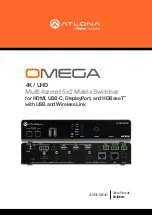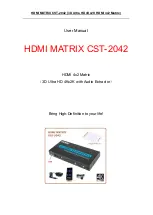
Class of Service (CoS)
63
Class of Service (CoS)
This section describes the Class of Service (CoS) Queue Mapping and CoS Interface
Configuration features.
CoS Queue Mapping
You can configure ports as trusted or untrusted.
Trusted ports have the following features:
z
Takes at face value certain priority designation for arriving packets
z
Trust only applies to packets that have that trust information
z
Can only have one trust field at a time
802.1p User Priority (default trust mode - Managed through Switching configuration)
IP Precedence
IP DiffServ Code Point (DSCP)
Untrusted ports have the following features:
z
No incoming packet priority designation is trusted, therefore the port default priority value
is used
z
All ingress packets from Untrusted ports, where the packet is classified by an ACL or a
DiffServ policy, are directed to specific CoS queues on the appropriate egress port. That
specific CoS queue is determined by either the default priority of the port or a DiffServ or
ACL.
z
Used when trusted port mapping is unable to be honored - i.e. when a non-IP packet
arrives at a port configured to trust IP precedence or IP DSCP
Packets arriving at the port ingress are inspected and their trusted field value is used to
designate the CoS queue where the packet is placed when forwarded to the appropriate egress
port. You configure a CoS mapping table to associate the trusted field value with the desired
CoS queue.
The three internal traffic class queues available are:
z
Queue 2 - Minimum of 50% of available bandwidth
z
Queue 1 - Minimum of 33% of available bandwidth
z
Queue 0 - Lowest priority, minimum of 17% of available bandwidth
For untagged traffic, you can specify default 802.1p priority on a per-port basis.
NOTE:
From the Web interface, you map IP Precedence and IP DSCP values to the internal
traffic classes on the QoS > Class of Service > Mapping Table Configuration page
and you map 802.1p priority values to the traffic classes on the Switching > Class of
Service > 802.1p Priority Mapping page.
Summary of Contents for DES-3226L
Page 2: ......
Page 6: ...6 Web User Guide...
Page 8: ...8 Web User Guide...
Page 30: ...30 Web User Guide...
Page 36: ...36 Web User Guide...
Page 44: ...44 Web User Guide...
Page 52: ...52 Web User Guide Figure 15 System Port Multiple Port Mirroring...
Page 58: ...58 Web User Guide...
Page 70: ...70 Web User Guide...
Page 75: ...Registration 75 Registration...
Page 76: ...76 Web User Guide...
Page 77: ...Technical Support 77 Technical Support...
Page 78: ...78 Web User Guide...
Page 79: ...Technical Support 79...
Page 80: ...80 Web User Guide...
Page 81: ...Technical Support 81...
Page 82: ...82 Web User Guide...
Page 83: ...Technical Support 83...
Page 84: ...84 Web User Guide...
Page 85: ...Technical Support 85...
Page 86: ...86 Web User Guide...
Page 87: ...Technical Support 87...
Page 88: ...88 Web User Guide...
Page 89: ...Technical Support 89...
Page 90: ...90 Web User Guide...
Page 91: ...Technical Support 91...
Page 92: ...92 Web User Guide...
Page 93: ...Technical Support 93...
Page 94: ...94 Web User Guide...
Page 95: ...Technical Support 95...
Page 96: ...96 Web User Guide...
Page 97: ...Technical Support 97...
Page 98: ...98 Web User Guide...
Page 99: ...Technical Support 99...
Page 100: ...100 Web User Guide...
Page 101: ...Technical Support 101...
Page 102: ...102 Web User Guide...
Page 104: ...104 Web User Guide...
Page 106: ...A 2 Web User Guide...
Page 108: ...B 2 Web User Guide...
Page 110: ...C 2 Web User Guide...
















































